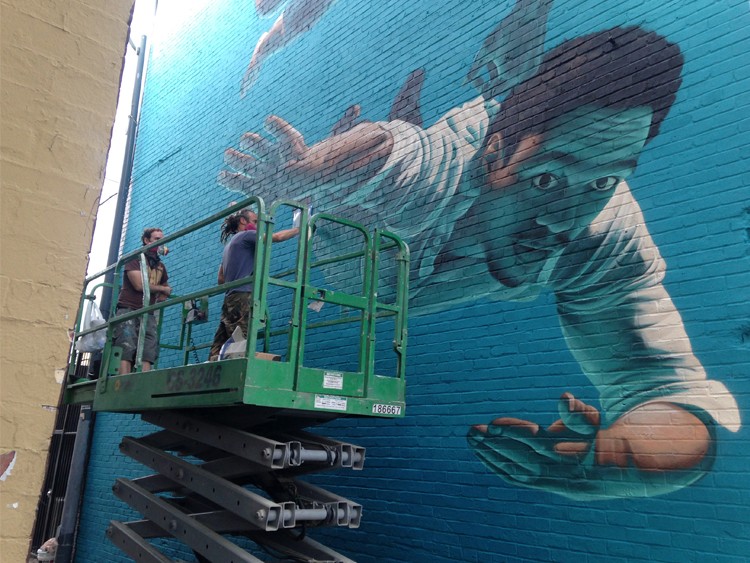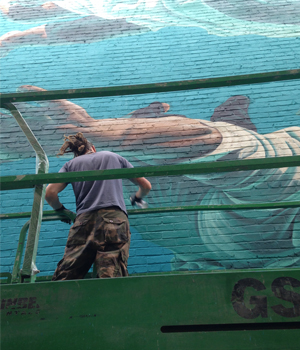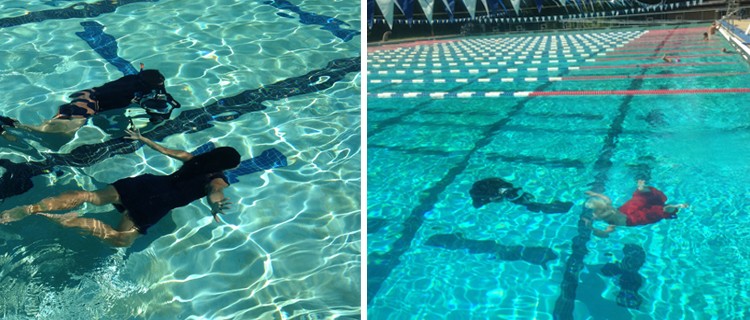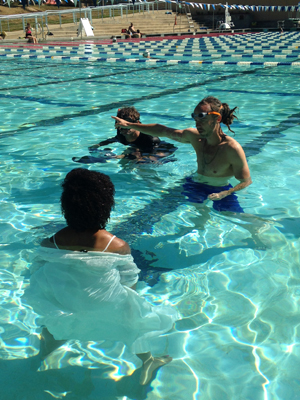As artist James Bullough creates a mural at 905 U Street, NW, The Phillips Collection asks him a few questions about his vision and process. Read Part 1 here.
How do you feel your mural proposal speaks to the U Street neighborhood? To the city at large?
Without giving too much away, I wanted to bring a calm and relaxing piece of art to an area that is anything but. The underwater color pallet and sense of quiet calm that the floating figures will create will be a nice relief from the chaos and hustle of a busy city street. Just below the surface, however, this piece may also speak to the feeling often shared among people living in a big city; that they are lost in a world that’s too big for them, one that they are powerless to impact or even be seen in… then again, maybe it doesn’t have anything to do with that.
What is most challenging about being a mural artist?
The most difficult part for me in creating any work of art is developing an interesting and innovative idea for every piece. I try to do something new with every painting, but as my schedule for both mural work and studio/gallery work fills and fills, it becomes increasingly hard to come up with new and interesting ideas at such a rapid pace. I have a very high standard for myself and keeping up with my own self imposed criteria and criticisms is a major task to say the least.
These questions largely focus on your mural painting. Have you or do you work in other mediums?
My studio work is mostly one of two mediums. I paint with oils and I draw with pencil. My oil paintings can be on canvas, panel, or often times on interesting pieces of wood that I find on the streets of Berlin or on my travels. The subject matter of my studio work tends to be more provocative than my public artwork and often revolves around the female nude or semi-nude figure. Pencil illustration is another love of mine but in the art world, unfortunately, an oil painting has a much higher value than a pencil drawing and as I have streamlined my painting process over the past year or so, it takes me about the same amount of time to do a nice pencil drawing as it does to do an oil painting so I haven’t done much drawing lately.
Are there any artists, art historical or otherwise, who inform your work?
One of my biggest influences historically was Egon Schiele who painted the human form in a groundbreaking and innovative way even though it cost him greatly. The Avant Garde nature of his work is hugely inspirational and motivated me as a developing artist to push myself.
To be honest though, most of my influences are and always have been young contemporary artists. Specifically, people around my own age and with similar aesthetic sensibilities. Artists like Conor Harrington, Erik Jones, Jaybo Monk, Etam Crew, and pretty much any living realistic oil painters. Feeding off of other artists’ energy, drive, and motivation is one of the biggest things that fuels my fire and pushes me to stay on top of my game and keep competitive with an ever-expanding and increasingly exceptional group of peers.
How has your work changed over the years?
My work is constantly changing. The realism is getting more and more real as I have more experience with my materials and techniques and I continue to push myself to dissect, fracture, distort, and manipulate my subjects in new and interesting ways. Hopefully this process will continue and the “changing” will never stop.





